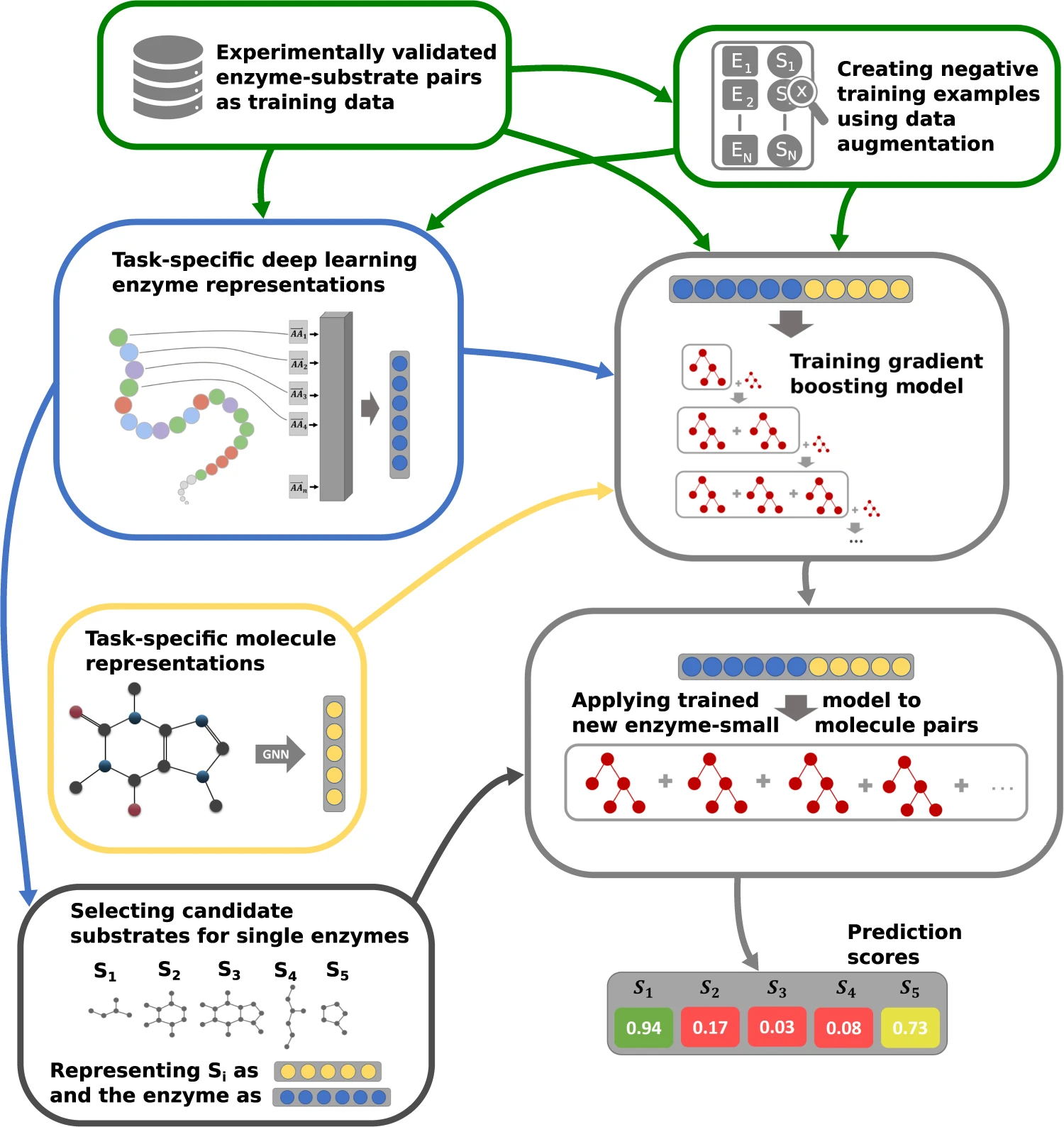Overview
Predictive modeling for AI-guided enzyme design involves using computational techniques, statistical models, and machine learning algorithms to predict and analyze various aspects of enzyme behavior, properties, and performance. It plays a crucial role in accelerating the enzyme design process by providing insights and guidance for selecting or designing enzyme variants with desired characteristics. Our predictive modeling method can accelerate the discovery and optimization of enzymes with tailored properties for you.
 Fig. 1. Enzyme Substrate Prediction model. (Kroll, A.; et al. 2023)
Fig. 1. Enzyme Substrate Prediction model. (Kroll, A.; et al. 2023)
Our Services
- Property Prediction: Predictive modeling aims to estimate enzyme properties that are relevant to the design process. This includes predicting substrate specificity, binding affinity, catalytic activity, selectivity, stability, and other functional or structural properties. By analyzing data from experimental measurements or databases, predictive models can infer how an enzyme may behave under specific conditions or with different substrates.
- Machine Learning Algorithms: Predictive modeling relies on machine learning algorithms to analyze enzyme data and make predictions. These algorithms learn patterns and relationships from training data, enabling them to make accurate predictions on new, unseen data. Supervised learning algorithms are commonly used, where models are trained using labeled datasets that associate enzyme features with desired properties. Unsupervised learning and deep learning algorithms may also be employed to uncover hidden patterns or extract features from large-scale enzyme datasets.
- Data Integration and Feature Engineering: High-quality data is essential for building reliable predictive models. Data integration involves combining diverse sources of enzyme information, including sequence data, structural data, reaction kinetics, and experimental measurements. Feature engineering is the process of selecting or creating informative features from the available data, which can enhance the predictive power of the models. Expert knowledge and domain-specific insights play a crucial role in this step.
- Design Space Exploration: Predictive modeling allows for efficient exploration of the design space for enzyme variants. By using computational algorithms, models can predict the effects of amino acid substitutions, insertions, deletions, or modifications on enzyme behavior. This enables researchers to evaluate a vast number of potential designs in silico, narrowing down the options and identifying promising candidates for further experimental validation.
- Iterative Optimization: Predictive modeling facilitates an iterative optimization process in which design strategies are continuously refined based on experimental feedback. By comparing predictions with experimental results, models can be updated and improved, enabling more accurate predictions and guiding subsequent design iterations. This iterative approach helps optimize enzyme variants over multiple cycles, achieving desired properties or specific performance objectives.
- Integration with Experimental Validation: Predictive modeling is most effective when combined with experimental validation. Experimental data provides crucial feedback to refine and validate the predictive models. By comparing predictions with actual results, models can be validated and calibrated, increasing their accuracy and reliability. The iterative collaboration between predictive modeling and experimental validation enables a feedback loop that enhances the overall success of AI-guided enzyme design.
Predictive modeling for AI-guided enzyme design empowers researchers to explore and analyze vast design spaces, guiding the selection or creation of enzyme variants with desired properties. It accelerates the discovery process, reduces experimental costs, and enables the creation of enzymes optimized for specific applications in areas such as biotechnology, pharmaceuticals, and industrial processes.
Please Contact us today to discuss your enzyme design needs and explore how our Predictive Modeling services can propel your AI-guided enzyme design projects. Together, let's unlock the full potential of AI to drive innovation and create enzymes with enhanced properties for a wide range of applications.
Reference
- Kroll, A.; et al. A general model to predict small molecule substrates of enzymes based on machine and deep learning. Nature Communications. 2023. 14(1): p. 2787.

































 Fig. 1. Enzyme Substrate Prediction model. (Kroll, A.; et al. 2023)
Fig. 1. Enzyme Substrate Prediction model. (Kroll, A.; et al. 2023)